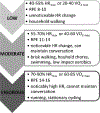The Role of Physical Activity in Preconception, Pregnancy and Postpartum Health
- PMID: 27169984
- PMCID: PMC6986386
- DOI: 10.1055/s-0036-1583530
The Role of Physical Activity in Preconception, Pregnancy and Postpartum Health
Abstract
The rise in obesity and associated morbidity is currently one of our greatest public health challenges. Women represent a high risk group for weight gain with associated metabolic, cardiovascular, reproductive and psychological health impacts. Regular physical activity is fundamental for health and well-being with protective benefits across the spectrum of women's health. Preconception, pregnancy and the early postpartum period represent opportune windows to engage women in regular physical activity to optimize health and prevent weight gain with added potential to transfer behavior change more broadly to children and families. This review summarizes the current evidence for the role of physical activity for women in relation to preconception (infertility, assisted reproductive therapy, polycystic ovary syndrome, weight gain prevention and psychological well-being) pregnancy (prevention of excess gestational weight gain, gestational diabetes and preeclampsia as well as labor and neonatal outcomes) and postpartum (lactation and breastfeeding, postpartum weight retention and depression) health. Beneficial outcomes validate the importance of regular physical activity, yet key methodological gaps highlight the need for large, high-quality studies to clarify the optimal type, frequency, duration and intensity of physical activity required for beneficial health outcomes during preconception, pregnancy and postpartum.
Thieme Medical Publishers 333 Seventh Avenue, New York, NY 10001, USA.
Figures



Similar articles
-
Psychological Health and Lifestyle Management Preconception and in Pregnancy.Semin Reprod Med. 2016 Mar;34(2):121-8. doi: 10.1055/s-0036-1571352. Epub 2016 Feb 9. Semin Reprod Med. 2016. PMID: 26859253 Review.
-
The effect of weight management interventions that include a diet component on weight-related outcomes in pregnant and postpartum women: a systematic review protocol.JBI Database System Rev Implement Rep. 2015 Jan;13(1):88-98. doi: 10.11124/jbisrir-2015-1812. JBI Database System Rev Implement Rep. 2015. PMID: 26447010
-
Type 1 and Type 2 Diabetes Preconception and in Pregnancy: Health Impacts, Influence of Obesity and Lifestyle, and Principles of Management.Semin Reprod Med. 2016 Mar;34(2):110-20. doi: 10.1055/s-0035-1571196. Epub 2016 Feb 8. Semin Reprod Med. 2016. PMID: 26854707 Review.
-
Excess Gestational Weight Gain in Pregnancy and the Role of Lifestyle Intervention.Semin Reprod Med. 2016 Mar;34(2):e14-21. doi: 10.1055/s-0036-1583531. Epub 2016 May 24. Semin Reprod Med. 2016. PMID: 27218282 Review.
-
Lifestyle Factors Focused on Diet and Physical Activity: Recommendations Preconception and During Pregnancy.Semin Reprod Med. 2016 Mar;34(2):65-6. doi: 10.1055/s-0036-1572354. Epub 2016 Feb 8. Semin Reprod Med. 2016. PMID: 26854710 No abstract available.
Cited by
-
The Impact of Physical Activity and Inactivity on Cardiovascular Risk across Women's Lifespan: An Updated Review.J Clin Med. 2023 Jun 28;12(13):4347. doi: 10.3390/jcm12134347. J Clin Med. 2023. PMID: 37445383 Free PMC article. Review.
-
Exercise in Pregnant Women with Diabetes.Curr Diab Rep. 2019 Aug 6;19(9):80. doi: 10.1007/s11892-019-1204-8. Curr Diab Rep. 2019. PMID: 31388772 Review.
-
A Pedometer-Guided Physical Activity Intervention for Obese Pregnant Women (the Fit MUM Study): Randomized Feasibility Study.JMIR Mhealth Uhealth. 2020 May 26;8(5):e15112. doi: 10.2196/15112. JMIR Mhealth Uhealth. 2020. PMID: 32348280 Free PMC article. Clinical Trial.
-
Preconception Physical Activity and Maternal Health Outcomes: An Integrative Review of Studies from 2016-2025.Matern Child Health J. 2025 Jul;29(7):857-869. doi: 10.1007/s10995-025-04086-7. Epub 2025 Mar 19. Matern Child Health J. 2025. PMID: 40102326 Review.
-
Enhancing Accessibility of Physical Activity During Pregnancy: A Pilot Study on Women's Experiences With Integrating Yoga Into Group Prenatal Care.Health Serv Res Manag Epidemiol. 2019 Apr 4;6:2333392819834886. doi: 10.1177/2333392819834886. eCollection 2019 Jan-Dec. Health Serv Res Manag Epidemiol. 2019. PMID: 30993148 Free PMC article.
References
-
- Australian Bureau of Statistics. Australian Health Survey: updated results, 2011–2012. ABS cat no 4364055003 Canberra: ABS; Available from: http://wwwabsgovau/ausstats/abs@nsf/Lookup/4364055003Chapter12011-2012 [Accessed 16/11/2015]. 2013.
-
- Australian Institute of Heath and Welfare (AIHW). Who is Overweight? Available From: http://www.aihw.gov.au/who-is-overweight/ [Accessed 23/11/2015]. Canberra: AIHW.
-
- Chu SY, Callaghan WM, Bish CL, D’Angelo D. Gestational weight gain by body mass index among US women delivering live births, 2004–2005: fueling future obesity. Am J Obstet Gynecol 2009; 200(3):271.e1–271.e7 - PubMed
-
- Harrison CL, Teede HJ, Lombard CB. How effective is self-weighing in the setting of a lifestyle intervention to reduce gestational weight gain and postpartum weight retention? Aust N Z J Obstet Gynaecol 2014;54(4):382–385 - PubMed
Publication types
MeSH terms
Grants and funding
LinkOut - more resources
Full Text Sources
Other Literature Sources
Medical

